This period in Greece was a time of significant political, cultural, and economic change. It witnessed the rise and fall of powerful city-states, the expansion of Greek influence across the Mediterranean, and Rome's eventual conquest.
One of the most notable developments during this period was the standardization of coinage. This facilitated trade and commerce across the Greek world.
Greek coins became renowned for their artistic merit. They featured intricate designs of gods, goddesses, heroes, and mythological scenes. Production techniques improved measurably, producing some of the most beautiful coins ever struck.
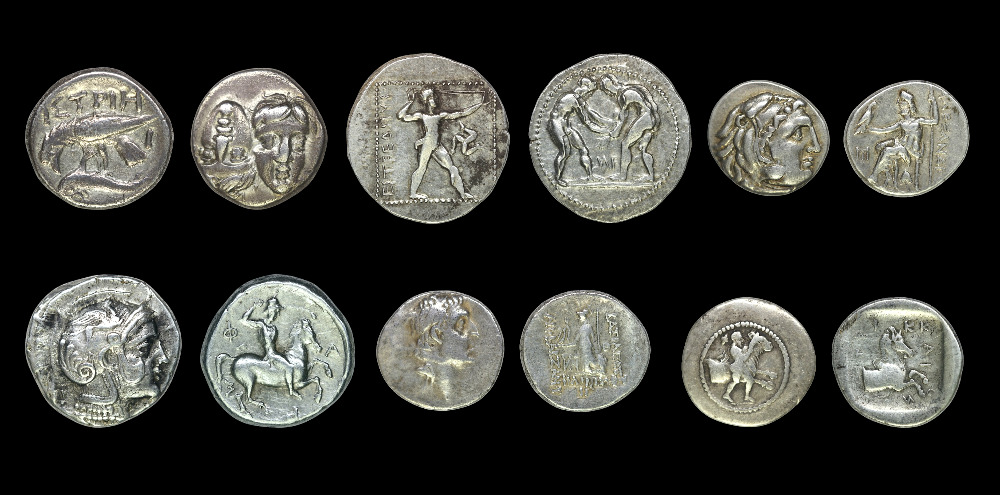
A selection of Ancient Greek silver coins from this period currently in stock.
Top left. Silver Stater from Istros a Greek colony in the Thrace region in southeastern Europe, north of Greece on the western shore of the Black Sea (modern-day Romania). Struck between B.C. 400-350.
Obverse two male heads representing the Dioscuri (Caster and Pollux), twin brothers from Greek mythology. The reverse features a sea eagle grasping a dolphin.
Top center. Silver stater from Aspendos, Pamphylia, dating from B.C. 370-333.
Obverse: Two wrestlers grappling, with letters between. This motif was common on Greek coins of this period, symbolizing athleticism and victory. The reverse features a slinger in a throwing stance, with a trickles symbol.
Top right. Alexander III, The Great, King of Macedon.
Silver Drachm, issued after Alexander's death in 323 BC, at the city mint Abydos, located in present-day Turkey BC 310-301.
Obverse: head of Herakles, wearing a lion skin.
Reverse: Legend, AΛEΞANΔPOY. Zeus seated left on low throne, holding a long sceptre in his left hand and an eagle standing right with closed wings in his right. MY, monogram left, below throne, Ivy leaf.
Bottom row left. Pamphylia, Aspendos Silver Stater B.C. 370-333.
Aspendos, located in the historical region of Pamphylia (present- day Turkey).
Bottom row center: Silver Drachm circa B.C. 65-64.
Ariobarzanes I, client King of the Roman Empire, he ruled over the region of Cappadocia ( present-day Turkey).
Obverse: Ariobarzanes I.
Reverse: Athens standing left; holding Niki, shield and spear, monogram in the left field.
Bottom right: Thessaly, Trikka, (present-day city Thessaloniki in northern Greece), was an important city in ancient Greece.
AR Hemidrachm B.C. 65-64, (half the value of a Drachm).
Obverse: Youthful hero Thessalos, nude, but for petasus hanging from neck and chlamys, restraining forepart of a bull right by band around its neck.
Reverse: TΡIKKAIΩN. Forepart of bridled horse right, all within incuse square.
The American War of 1812.
United States of America against the British Empire and its First Nation allies.
There were many reasons for the War of 1812.
One of these factors was the United State's motivation to uphold honour in the face of what they considered to be British insults, such as the 'Chesapeake' affair.
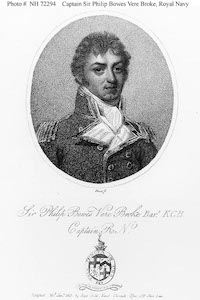
In 1813 the United States USS Chesapeake Navy frigate put out to sea from Boston Harbour to confront the British Royal Navy frigate HMS Shannon. A short but intense battle ensued, resulting in the death of the American captain James Lawrance, his ship the 'Cheseapeake' became badly damaged and unmanoeuvrable during the gun battle. The British then overwhelmed the stricken boat, during which the British captain Philip Broke was severely injured, but survived his wounds.
There was a heavy death toll from this battle, reports vary from 71 to well over a hundred and it was to be the only action involving frigates during this war.
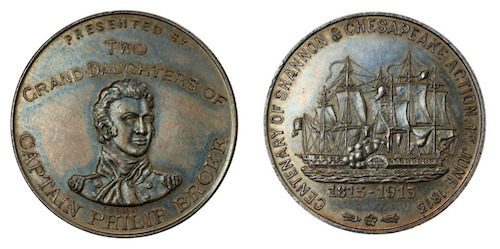
The British bronze medallion pictured commemorates the centenary of the 'Shannon' and 'Chesapeake' action, 1813 - 1913.
Obverse reads: PRESENTED BY THE TWO GRAND-DAUGHTERS OF CAPAIN PHILIP BROKE.
Reverse reads CENTENARY OF SHANNON & CHESAPEAKE ACTION, 1ST JUNE. 1813
The two granddaughters were Jane Anne Vere Broke (1850-1933). She married James St. Vincent Saumarez. Also Frederica Mary Horatia Broke (1855-1933), married Admiral Sir Lambton Loraine. Their father was Captain Charles Acton Vere broke, R.E. (1812-1856).
This medallion is available to purchase: SKU code: 16162.
Byzantine Empire under the Hereclian dynasty 610-695 A.D.
Heraclius, the first Emperor in this dynasty ruled from 5th October 610 to 11th February 641.
After the division in the Roman Empire in 395 A.D, the city of Byzantium was rebuilt and renamed Constantinople by Constantine the Great in 330 A.D. This great city was to become the administrative centre of the Eastern Roman Empire.
Heraclius reign was marked by several military campaigns. The Empire was threatened on multiple frontiers.
Byzantine - Sasanian War 602-628.
The Persian army fought their way to the Bosphorus, their advance halted by the imposing high walls protecting Constantinople, and the strong Byzantine navy. Heraclius avoided total defeat and rebuilt and strengthened the military and then managed to push the Persians out of Asia Minor and back into their territory, culminating in a decisive victory in 627 at the Battle of Nineveh. Heraclius then had to confront the Rashidun Caliphate from the Arabian Peninsula, these invaders conquered the remaining Sasanian empire and consequently, Heraclius lost the regained lands.
The coin featured is a Tremissis or trimis, a small gold coin of Late Antiquity, the name means "a third of a unit", and the semissis was half a unit. These coins were introduced into the Roman currency in 380's by Emperor Theodosius I and were minted into the reign of Leo II (717-741).
The featured coin was struck between 613-641 A.D. at Constantinople.
Obverse: Diademed, draped, and cuirassed bust of Heraclius. Legend: dn hERACLIVS T PP AVG.
Reverse: Cross potent. Legend: VICTORIA AYGY S/CONOB.
EF for the issue, reverse with die weak area.
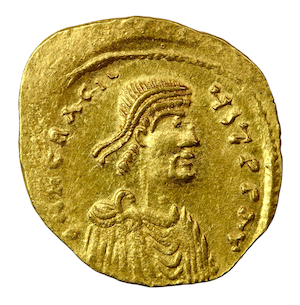
DOC 54, SB 787.
Alvise II Mocenigo 1700-1709.
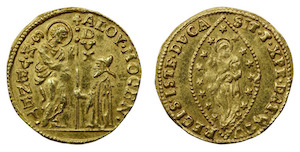
Third coin from the left and pictured at the start of this article.
Obverse: St. Mark the Evangelist patron saint of Venice, who is depicted with a beard and halo, standing facing right and wrapped in a large cloak while holding the Gospel with his left hand. The Doge knelling to his right, wears a fur-trimmed cloak and the ducal cap, under a banner with a cross on top, besides which in vertical letters "DUX". Doge Alvise II Mocenigo is the highest official of the Republic of Venice. Legend: ALOY MOCENI - S·M·VENET· Reverse: Full-length facing figure of Christ in beaded ellipse lined with stars. Legend: SIT·T·XPE. DAT.Q.TV REGIS·ISTE·DVCA. "Christ, let this duchy that you rule be given to you". The Design of these coins remained unchanged for over 500 years from 1284 to the fall of the Republic of Venice in 1797. Mint: Zacca mint of Venice from which the coin gets its name from 1543, originally named Ducat. Catalogue: Friedberg 1358.
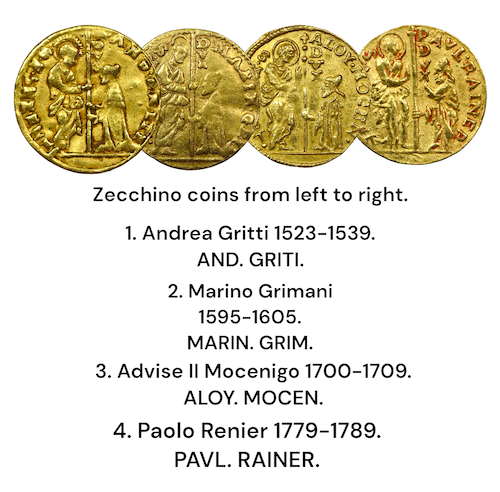
1489-1989.
The pound coin was introduced in 1489 by special commission of Henry VII. Struck in gold and featuring a design of the King enthroned in majesty, the new coin was to be known as the sovereign.
The sovereign continued to be struck until shortly after the accession of James I in 1603, when it was replaced by other gold coins, and eventually in 1663 by the guinea.
When it was re-introduced in 1817 by George III, the Sovereign was given a new reverse design by the Italian engraver, Bernedetto Pistrucci. The design depicts the slaying of the dragon by St. George. This popular design has become intimately linked with the sovereign, and has in fact appeared on all gold sovereigns from 1887 until 1988.
The 1989 Sovereign designs both of which are modern adaptations of the original sovereign design of 1489.
Obverse: A representation of Queen Elizabeth II Coronation, seated in King Edward's Chair and having received the Sceptre with the Cross and the Rod with the Dove, all within the circumscription ELIZABETh·II·DEI·GRA·REG·FID·DEF', which may be translated as Elizabeth II - by the grace of God, Queen defender of the faith. R. A Shield of Our Royal Arms endigned by an open Royal Crown, the whole superimposed upon a double Rose, with the circumscription ANNIVERSARY·OF·ThE·GOLD·SOVEREIGn·1489·1989.
Designs: Bernald Sindall.
Catalogue: Spink# SC3, KM# 956. The Gold Sovereign by Michael A. Marsh No. 313H.
Certifiate of Authenticity Number: 05678.
Rarity rating: S (scarce).
Specifications:
Weight: 7.98 grammes, 22.05mm struck in 22 carat gold (0.9167), thickness 1.52mm, edge milled.
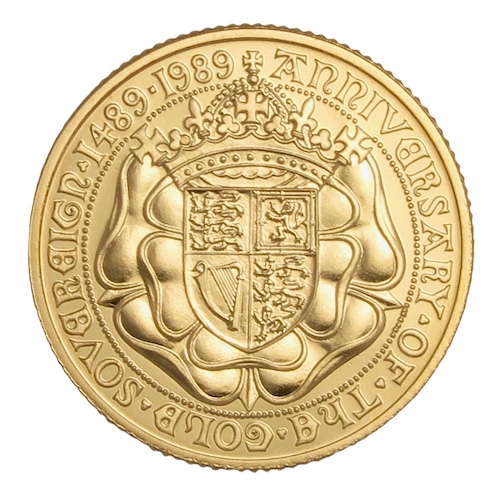
Halfpenny (small size), with a brass plug (crown on the obverse) impressed into the flan to help prevent counterfeiting and also to creat the illusion the royal crown is made of gold.
Obverse: King David kneeling playing a harp, while gazing up at the Crown of England. On the pillar of the harps leg is a semi-nude winged female figure.
Legend: FLOREAT REX. (May the King Flourish).
Reverse: St Patrick dressed as the pope with patriarchal cross driving away demons. Dublin cathedral on the right.
from IrelandLegend: QVIESCAT PLEBS. (May the People Be at Peace).
Catalogue: Spink# 6569.
Mint: Uncertain there are many theories, possibly Dublin or The Tower of London or even the Catholic Church.
There are two varieties, the Large size and the smaller size. The most likely date of mintage is 1646-1660 for the small and 1688-1690 for the large, both issues are Halfpennies.
There are reported to be many die variations and approximately 1,100 specimens known, probably a lot higher with so many die varieties suggests the coins were produced over a long period of time and probably at several mints at least.
Copper with brass insert, the worn example featured is 4.49g, 24mm with a milled edge.
Often found well worn and this coin is no exception.
Grade: US G-4.
A quantity of these coins circulated on the Isle of Man for a short period of time.
On 24th March, 1675 a boat sailing from Dublin to Chester sank and from the wreck a coin hoard was later retrieved, which included one of these St. Patrick's halfpennies.
In 1681 a Quaker, Mark Newby emigrated from Dublin Ireland to America with a quantity of these coins. He settled in Camden, West New Jersey and was instrumental in making these coins legal tender as Farthings in the region of New Jersey.
It is believed further striking of these coins were made in America in the following years.
Krause catalogue World coins 17th century lists a St. Patrick or Mark Newby Farthing (1682) KM# 1, and the larger issue as a Halfpenny KM#2.
United States coins (Red book), under Colonial Issues lists these coins under New Jersey. St. Patrick or Mark Newby Coinage.
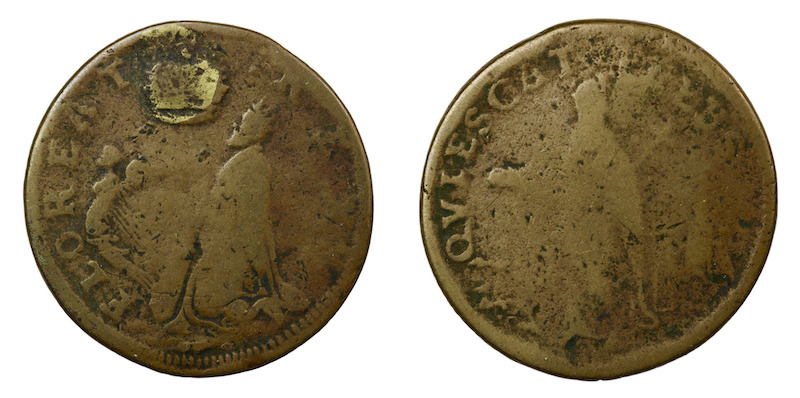

In 1995 a treasure of 1,582 hammered coins was found on the forshore of the River Thames in central London. Presumably lost by a trader around 1660, overboard in the river. With reclaimation in the last centuries, the site was discovered in 1995 at low tide, the coins encased in the dark mud, which is known to help preserve to a certain extent due to a lack of oxygen. These coins span many years, in fact over one hundred from the reigns of Edward VI to the Commonwealth, with the most represented from Charles I and the Commonwealth periods, which one would expect, but also surprisingly Elizabeth I. Included were several unrecorded Charles I half-crowns dated 1657 and 1659.
With the Restoration of the Monarchy in 1660, the Commonwealth coinage, after eleven years in circulation, was withdrawn, to be melted down and re-coined. People would have been anxious to return their old coins for new ones in fear of loosing this opportunity or possibly association with the ousted regime. These times were no doubt turbulent with the end of Oliver Cromwell and the Coronation of Charles II, for reasons we will never know, a bag of coins ended up in the river.
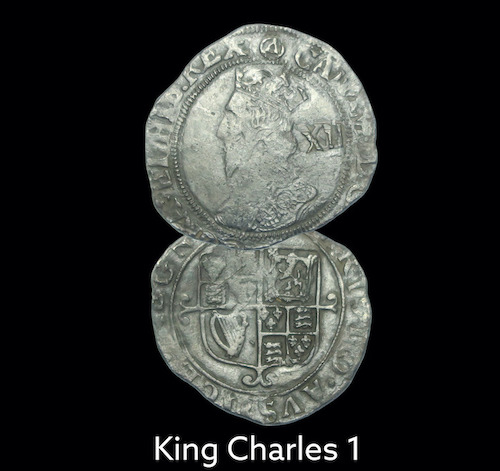
After a treasure trove inquest and examination by the Museum of London, many of the coins were put up for public purchase at auction.
This particular coin is a shilling from the reign of Charles I, minted at the Tower, under the King between 1641 and 1643. The obverse portrait of the King is wearing a double-arched crown and stellate lace collar and known as a sixth large 'Briot' bust, above which is the mint mark, a triangle in a circle. On the reverse is a square-topped shield over a cross moline. The coin's dark tone is the result of being in the river bed mud for over 300 years. The coin is heavily clipped a common practice at the time for which punishments were severe and being hung was preferable to the many more gruesom methods practiced at the time.
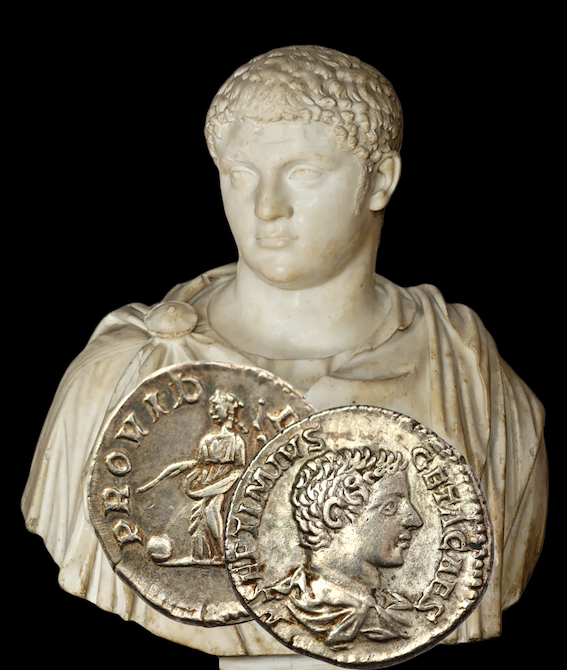
Publius Septimus Geta was born in Rome A.D. 189, the younger of two sons to Septimius Severus of the Severan Dynasty & his wife Julia Domna. His father was born in Lepicis Magna, modern day Khoms in North Africa and ruled Rome as a military dictator, along with his sons Caracalla & Geta as Caesars. Septimius Severus set out for Britain with a large army in excess of 35,000 soldiers in A.D. 208 after a plea by the localgovernor for help to combat rebellion in Caledonia, present day Scotland. Britain was at this time divided into two provinces, Britannia Superior (South) with Londinium (London) as its capital, and Inferior (North) with Eberacum (York) as its capital, this was to prevent too many troops being concentrated in the hands of a single governor who might try to usurp power. For three years the Roman Empire was ruled from Britain. The royal court with its bureaucracy was based in London or was it York, there are differing accounts. Septimius now aged 63 and his sons fought in northern Caledonia with some degree of victory achieved, and declared in A.D. 209-10, Severus and Caracalla at the age of 20 assuming the title of Britannicus. Revolts soon took place, which on the orders of Severius were to eradicate the Caledonians were put down without mercy by Caracalla. Ir appears geta was at this time in Eberacum with his Mother taking care of the affairs of State. Severius now in poor health, has been suffering from gout for some time and exhausted he returned to Eberacum and died there at the age of 65 February 4th A.D. 211. The troops acclaimed his sons as joint emperors. The deathbed wishes of severius were for his sons to jointly inherit the throne The joint rule was to last only 12 months, the two sons had fiercly quelled their entire life, their mother acting as mediator, it was to end tragically back in Rome with Geta's murder, Caracalla had his Praetorian Guards kill Geta in the arms of his mother, who was injured in the assassination. Caracalla attempted to eradicate Geta's memory and obliterate all records of his existence, Caracalla was himself later assassinated by a Roman soldier, his unfortunate mother Julia Domna at this time suffering from what is believed to have been breast cancer committed suicide. The coin illustrated is a AR Denarius from the Rome mint A.D. 209-212, depicting Geta as Caesar with the Roman God Providentia on the reverse, a divine personification of the ability to foresee and make provision, which tragically did not work for him. The obverse reads Publius Septimius Geta, Caesar and the reverse, Foresight of the Gods.
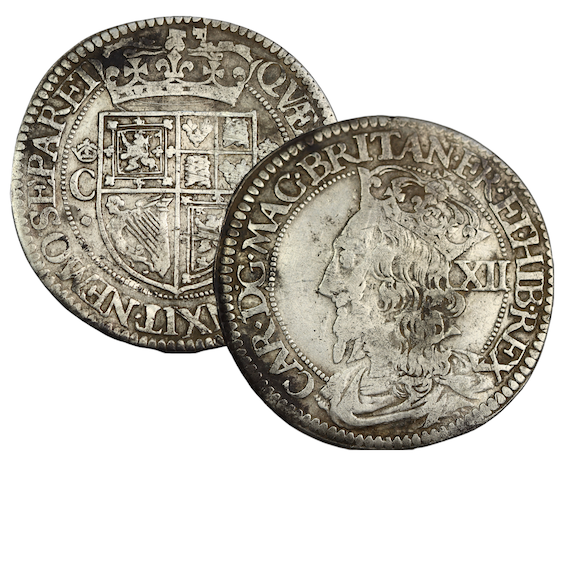
Charles was born into the House of Stuart, the second son of James VI of Scotland, and Ann of Denmark at Dunfermline Palace in 1600. With the accession of his father to the English throne in 1603, Charles moved to England. He became King of his three kingdoms, England, Scotland and Ireland on 27th March 1625 on the death of his father, and married by proxy Princess Henrietta Maria of France in June the same year at the age of 25. The new King's coronation in Scotland, however, did not take place until 1633, some eight years later due to the turbulent political situation north of the border at the time. A special directive was made authorizing the use of old dies of the coinage of his farther James VI to be used for minting coins until new dies could be prepared by Charles Dickinson. These coins are known as the first coinage. Coins bearing the new King's image from 1634 are known as the second coinage, and were minted by Nicholas Briot, a Frenchman previously employed at the French & English mints; he was later joined by his son-in-law John Falconer of Renfrewshire, Scotland, who eventually succeded him as master of the mint. The Twelve shillings coin featured here is from the third coinage period, 1637-42, and features an 'F' on its side above the crown, for Falconer, the crown has a central lis for Scotland, wheras some issues used the English cross in the crown. This coin was minted in Edinburgh; the thistle mint mark is on the reverse at the start of the legend, which translates: Charles, by the Grace of god, King of Great Britain France & Ireland. CAROLVS D G MAGN BRITAN FRAN ET HIB REX, with the value in Roman numerals VII behind the kings bust. The reverse translation: What god hath joined together, let no man put asunder. QVAE DEVS CONIVNXIT NEMO SEPARET. There was yet another coinage the Fourth from 1642, however, only a few minor denominations were struck, by this time the Civil War had started, culminating in King Charles execution in London on a cold January day in 1649.